Ye Pei Jian, Doctor of Science honoris causa

From the first artificial satellite to the BeiDou Navigation Satellite System, from the first rocket launcher to the first human spaceflight, and from the Tiangong-1 to the Chang’e landing on the moon, China has made remarkable achievements in its space program, which has enabled it to become one of the leading countries in space exploration. As the Chief Designer and Chief Commander of China’s orbital lunar probe program, the Chang’e-1 satellite system, Prof. Ye Pei Jian should undoubtedly be given the greatest credit.
Prof. Ye graduated from the Department of Radio Broadcasting, Zhejiang University in 1967, and then he went to pursue further studies in Neuchâtel, Switzerland, and obtained a PhD in Science in 1985. He was elected to be an academician of the Chinese Academy of Sciences in 2003. Prof. Ye was the Chief Designer and Chief Commander of China’s first-generation transmission reconnaissance satellite series; he oversaw the research and development of China’s first-generation long-life transmission earth observation satellites. Prof. Ye holds many significant posts in the field of China’s space science research and deep space exploration, including Chief Expert in Sun-synchronous Orbit, Chief Commander and Chief Designer of the Orbital Lunar Exploration Program and the Chang’e-1 satellite system, Chief Commander and Counselor of Chief Designer for all models of the Chang’e series, Chief Scientist of the Chang’e-3, and others. In research on overall design and information processing of satellites, Prof. Ye directed and formulated large-scale experiment plans such as electronic measuring, mechanics, noises, EMC, thermodynamic equilibrium and thermal vacuum, and organized the execution of all the projects, ensuring the high technology indexes of satellites. He’s presided over the revision to the amendment plans for the two succeeding satellites improving their property and standards, performed the dual-satellite navigation and the formulation of our country’s lunar probe satellite technology plan. In the area of astronautic computer applications, he’s participated in the development of the database, application software package, and manufacturing computer network environment for satellite and spacecraft design, which has played an important role in satellite development.
Prof. Ye once noted that “to conduct scientific research, we need a unique way of thinking, which combines strictness, meticulousness, cautiousness and practicality, but there is one more thing I’d like to add to this summary, that is, pursuit of perfection.” This remark could approximately summarize the professor’s own research spirit and attitudes. It is precisely because of such an attitude and spirit, as the Chief Commander and Chief Designer of China’s orbital lunar probe program, that Prof. Ye was able to achieve multiple successes in bringing China’s Chang’e lunar probe satellites to the enormous universe, winning honors for our country and earning a place for China in the world stage in the area of space science and deep space exploration.
As is indicated by the saying, “fame is the result of what a person can do”, Prof. Ye’s practical spirit and extraordinary contributions have earned him high national recognitions and awards. Starting from 1993 he begun to receive special government allowances, in 2000 he was elected to be one of the “Mid-aged and Young Experts with Outstanding Contributions” by the State Commission of Science and Technology for National Defense Industry and, in 2002, he won the China Space Foundation awards. Adding to this, he also won the special prize and first prizes of National Science and Technology Progress Awards and the National May 1 Labor Medal. In 2014, as the team leader, he won the innovative team award of the National Science and Technology Progress Awards. To ensure that our country has excellent younger talents that could further the country’s space program, Prof. Ye also works as a part-time professor of Tsinghua University, Zhejiang University, Beijing University of Aeronautics and Astronautics, and other higher institutions, dismissing the valuable experience and expertise he’s accumulated in practice to the diligent students, and has fostered a great number of doctors and masters, who have enriched and strengthened our country’s pool of space talents.
For the Chinese living in ancient times, Chang’e flying to the moon has always been a myth residing only in people’s imagination. However, today, thanks to the tenacious Chang’e spirit and the meticulous scientific qualities of our country’s first generation space explorers, the Chinese have finally succeeded in making the ancient myth a contemporary fact of truth, and earned a place in the world stage in space exploration.





